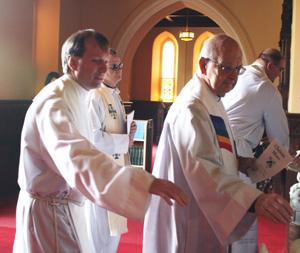
By Celine Klosterman
The Diocesan Planning Commission is working to accurately project the number of clergy available for parish ministry in coming years, and says all Catholics are called to creatively maintain a strong presence in the Davenport Diocese.
More than twice as many priests in parish ministry will reach retirement age as will be ordained from 2010-2020, the commission projects.
In numbers calculated last week, the commission forecasts that over the coming decade, 12 priests will be ordained and 25 priests in parish ministry will reach the retirement age of 70.
The 12-member lay and clergy commission also projects that another five clergy may need to leave parish ministry before they turn 70 due to illness or other unforeseen reasons.
In all, the number of priests in parish ministry who are younger than 70 is expected to drop from 60 in 2010 to 41 in 2020.
“This is the best projection we came up with at this time; hopefully things will be better than the numbers say,” said Father Jim Vrba, commission co-chair.
The commission will use the numbers to guide it as it develops a plan — with parishes’ and priests’ input — for parish and deanery structuring through 2020. The commission aims to submit that plan to Bishop Martin Amos by Advent 2010.
Projections assume all eight men now studying to be priests for the Davenport Diocese will be ordained. The man who most recently entered the seminary is on track to become a priest in 2016; the commission projects one ordination a year beginning in 2017.
Father Marty Goetz, diocesan vocations director, continues to promote religious vocations and is in contact with several men who’ve voiced interest in the priesthood. Vocations come from prayerful families who seek God daily, the commission said.
Projections don’t include the 14 diocesan priests serving outside of parishes — such as at hospitals, prisons and St. Ambrose University in Davenport. Projections also exclude the three diocesan priests serving outside southeast Iowa and the diocesan priest taking a leave of absence. Bishop Amos has said he doesn’t see the latter four clergy returning to active ministry in the diocese soon.
“As priests become fewer, Parish Life Administrators, deacons and folks in the Ministry Formation Program will be called on more often to help minister in parishes,” said Fr. Vrba. So will parishioners: “Every person in every parish has indispensable gifts for their parish’s mission,” he said.
How parishes fulfill their missions may change; parishes may need to share staffers or a pastor, merge or close. Planning for such cases should begin at the parish level, the commission has stressed.
Other dioceses, especially in the Midwest, are addressing situations similar to the Davenport Diocese’s, said Bishop Amos.
As it plans for the future, the Davenport Diocese’s commission is relying on the Holy Spirit’s guidance. At each monthly meeting, members spend about a half-hour in prayer before tackling the agenda, and return to a prayer throughout meetings to help discern the Holy Spirit’s call, said Fr. Vrba.
But they’re sure of one thing as the diocese’s landscape changes. “This is an opportunity for all of us to respond to our baptismal call, to minister to one another and proclaim the Gospel,” said Sister Laura Goedken, OP, commission member.
Bishop Amos also voiced optimism. “We are a hope-filled people living in the presence of God as we work to bring about his kingdom.”








